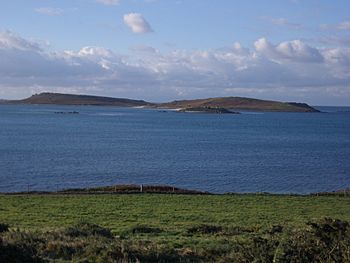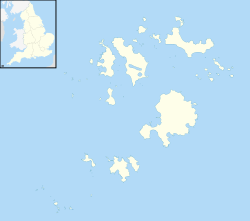Samson, Isles of Scilly facts for kids
|
Enys Samson
|
|
|---|---|

A view of Samson from Tresco
|
|
| Etymology | Samson of Dol |
| Geography | |
| Coordinates | 49°56′00″N 6°21′10″W / 49.9332°N 6.3529°W |
| OS grid reference | SV877127 |
| Archipelago | Isles of Scilly |
| Area | 0.15 sq mi (0.39 km2) |
| Administration | |
|
United Kingdom
|
|
| Civil parish | Tresco |
| Demographics | |
| Population | 0 |
Samson (Cornish: (Enys) Sampson) is the biggest island in the Isles of Scilly that no one lives on. These islands are located off the southwest tip of Cornwall, Great Britain. Samson is about 38 hectares (0.15 square miles) in size.
The island has two main hills, called North Hill and South Hill. These hills are connected by a narrow strip of land known as an isthmus. Long ago, the people who lived on Samson built their strong stone houses on this isthmus. The island was named after a historical figure called Samson of Dol.
Contents
Samson's Past: A Look at Its History
The two hills on Samson island have very old burial grounds. These ancient sites are found on both North Hill and South Hill. They show that people lived and were buried here a long, long time ago.
When Did People Live on Samson Island?
Samson island was home to people until the year 1855. At that time, the owner of the land, Augustus Smith, decided to move the remaining families off the island.
The people living there were facing very tough times. They often had little food, mainly eating limpets (a type of seashell creature) and potatoes. Only two families, the Woodcocks and the Webbers, were left on the island when they were moved.
After the families left, Augustus Smith tried to create a deer park on Samson. However, the deer managed to escape from their stone-walled area. Some even tried to walk across the water to the nearby island of Tresco when the tide was low.
In August 1933, a large fire broke out on the island. Staff working for Major Dorrien-Smith helped put out the fire. They dug ditches to stop the flames from spreading across the island.
Why is Samson Island Important for Nature?
Today, Samson island is a special place for wildlife. It is a protected area where many different birds and wild flowers thrive. You can find birds like terns and gannets living here.
In 1971, Samson and several nearby islands (Green Island, Puffin Island, Stony Island, and White Island) were named a Site of Special Scientific Interest (SSSI). This means they are very important for their unique plants and animals, and they are protected to keep them safe.
How Many People Lived on Samson?
Here's a quick look at how the population of Samson changed over time:
- 1669: Just one family lived on the island.
- 1715: Only three men were strong enough to carry weapons.
- 1751: There were two households living there.
- 1794: Six households called Samson home.
- 1816: About forty people lived on the island.
- 1822: Seven households, with a total of thirty-four people.
- 1851: Three households remained.
- 1855: Augustus Smith moved the last two families off the island.
Visiting Samson: What Can You See?
You can take boat trips to Samson island regularly from May to September. There isn't a proper quay (a dock for boats), so visitors step off the boat using a wooden plank.
Once on the island, you can explore the remains of the old stone cottages where people used to live. You can also see what's left of Smith's deer park and ancient burial sites called prehistoric entrance graves.
There are no shops, cafes, or other services on the island. However, local experts often lead guided walks. They can tell you all about Samson's history and nature.
Samson in Stories and Books
Samson island has appeared in several books and stories:
- The island is a key part of the children's story Why the Whales Came by Michael Morpurgo. In the book, Samson is under a special curse that needs to be broken.
- It also features in Armorel of Lyonesse by Walter Besant. Many people believe that Webber's Cottage on Samson was the inspiration for Armorel's house in the story.
- Samson appears in the fantasy novel Stone In The Blood by Colin Jordan & David England. A character named Peter visits the island in 1974 and also in the Iron Age, where the hills are home to a community.
- In the old medieval story of Tristan and Iseult, Samson is where the hero Tristan defeats a knight named Morholt.
- The island is also featured in the novel The Dangerous Islands by Ann Bridge.
Images for kids



